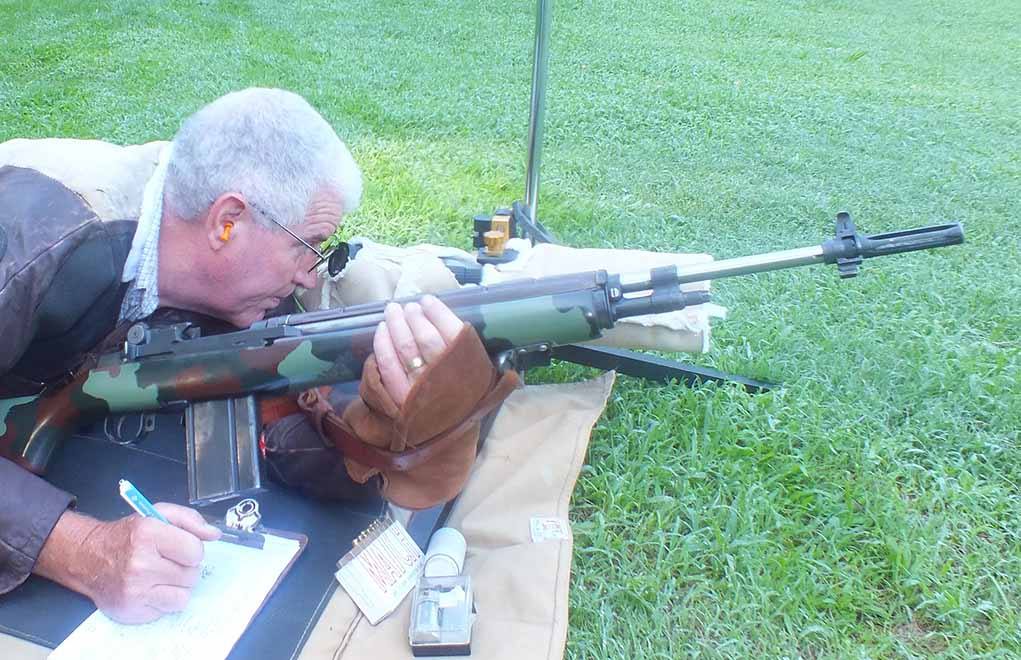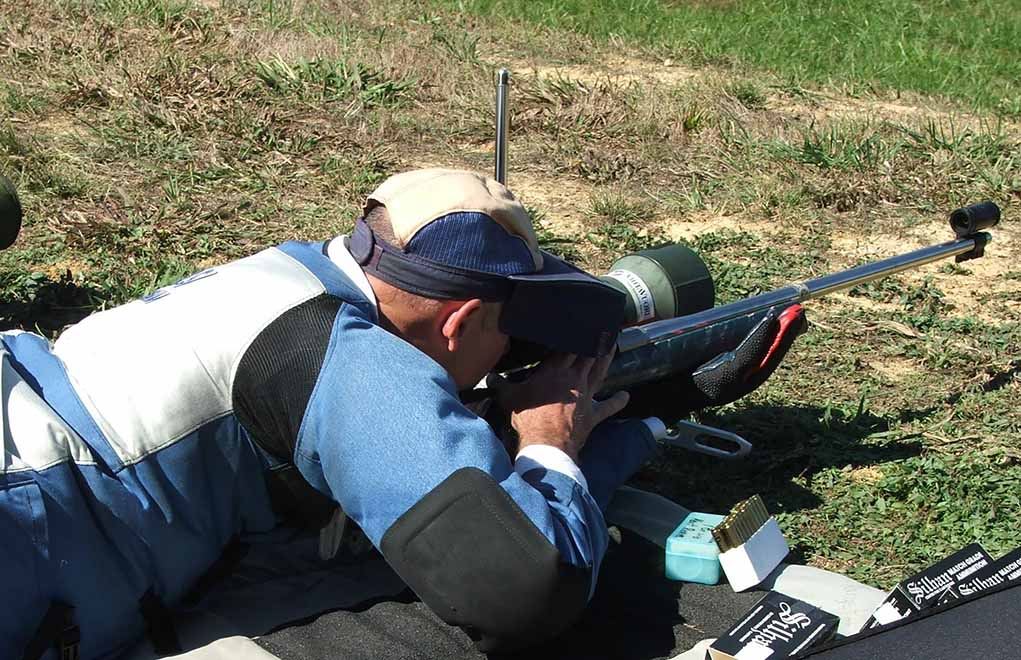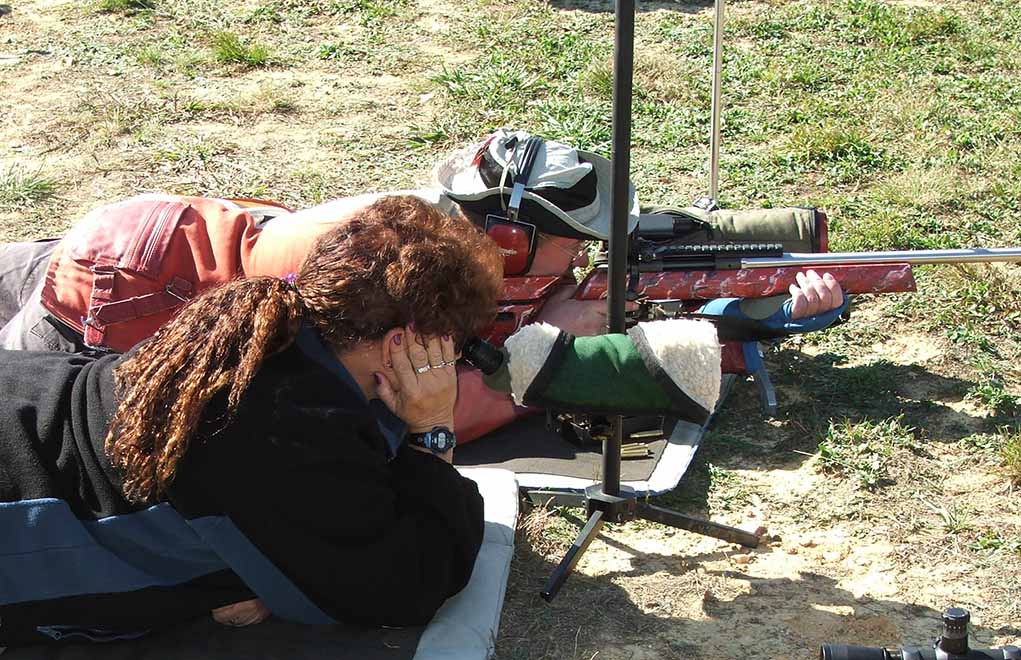
Products and theories evolve quickly in the shooting world, but you still get to decide what works for you. A mix of old and new is a lethal combination when it comes to long-range shooting.
How do old and new school long-range shooting methods measure up:
- Milrads are easier to convert, but it's easier for many Americans to think in MOA.
- Short, stiff barrels are stiff, but long barrels mean more velocity and resistance to wind deflection.
- Metering only measure wind where you're at, while mirage tells you what's happening down range.
- Wind-resistant calibers mean less compensation, but might equate to less barrel life.
- You get to use the has marks and range find with a FFP scope, but the reticle but is tiny up close and large at long range.
We were on the 400-yard line at Camp Perry, on Rodriguez Range, and nearing the end of the first and only National Defense Match. The match had started at 10 yards with the emphasis on speed, but it ended up at the 500-yard line where accuracy and the ability to judge conditions closed the deal.

The entire match was fired without the benefit of a spotting scope or flags to read the wind. There was a steady right to left wind and a lot of conversation and speculation about how much windage to use. There were mathematic calculations of wind speed versus directional wind value. Smartphones were being consulted and I suspect there was a wind meter involved.
Chris and Colton Cerino (yes, the “Top Shot” guy) were shooting with my grandson, Phoenix, and me. Knowing I’d shot a lot at Camp Perry, Chris asked me how much windage we should use. I plucked a handful of grass and dropped it from shoulder height.
“Put on 3 minutes,” I answered, “Old school wind meter.”
As I was saying it, one of the smartphone guys spoke up, “Looks like 3 minutes.”
I smiled. Phoenix, Chris, Colton and I all cleaned-up on the long range stages.
I’m a bit wary about writing an old school article like this for fear of being accused of imitating Elmer Keith, but sometimes the old stuff works just fine. In fact, I suspect some of the new ideas might be counterproductive.
MOA Vs. Milrads
When I was in 5th grade, I distinctly remember Mr. York telling my class how the metric system was going to simplify the world. He explained how it was a simpler system than our fractional “inch” system, and how easy it was to simply measure in millimeters.
Once we adapted the metric system, he said, there’d be a universal measurement system all over the world and mechanics could work on foreign cars and USA cars using the same set of tools. He was right. We adapted the metric system — sort of — and now a mechanic has only one set of tools, consisting of both metric and inches, sockets and wrenches.

There’s nothing wrong with milrads, provided you’re a person who only thinks in Milrads. Both systems are methods of angular measurement and nothing more. No matter how many scopes I use that are measured in milrads, I’ll always instantly convert the movement in my mind to MOA.
Since most Americans think in terms of degrees, inches and yards, it’s easier to explain and understand MOA. Maybe you can think milrads without mentally converting them to inches, but I can’t.
One MOA equals about 1 inch at 100 yards. One milrad equals 3.6 MOA. One-tenth milrad equals about 1 centimeter at 100 yards. Most of us think in yards, most of us think in inches. Most MOA scopes have turrets graduated in ¼-MOA increments, which equal ¼-inch at 100 yards. Most milrad scopes divide clicks into 1/10 milrads, which, again, equal about 1 centimeter at 100 yards.
More Long-Range Shooting Info:
- Buying the Perfect Precision Scope
- Ballistics Basics: Initial Bullet Speed
- The Effects Of Air Temperature On Bullet Flight
- Mils vs. MOA: Which Is The Best Long-Range Language?
If you mentally think centimeters, milrads are the system for you. You’ve certainly heard countless arguments dictating which you should use. None are right and none are wrong.
Personally, however, I don’t remember anyone I know describing a fish or deer antlers, or anything else, in centimeters. My advice: Don’t feel pressured to switch to milrads if you’re perfectly happy working with MOA. The shooting industry has been using one measurement system for the last 100 years or so, and now we have a new one. Mr. York would be proud.
Barrel Length Conundrums
For the life of me, I can’t understand the recent trend of short barrels on rifles designed for long range. Rifles currently designed for long range now come with barrels as short as 16 inches on semi-autos and 20 inches on bolt-action rifles.
When I was shooting 600 and 1,000 yards in my High Power career, my M14 had a 22-inch barrel and I’d have loved to have 4 more inches of tube out front so I could better compete with my bolt-gun-shooting friends with their 26-inch barreled Model 70s.

In centerfire rifles, barrel length means velocity — and velocity means less wind deflection. This is why Palma, F Class and long-range sling shooters use 30-inch and longer tubes. Yes, short and stiff barrels can be more accurate than longer and whippier ones, but at long ranges, resistance to wind deflection is important. Won’t somebody out there market a precision .308 Win. with a barrel longer than 20 inches?
Wind Metering Vs. Mirage
Don’t get me wrong: I’d have loved a wind meter when I was coaching at Camp Perry, but I suspect some of the newer generation put a bit more faith in their wind meters than reality merits. Wind meters measure wind where you are, and the wind where you are isn’t the wind you shoot through. At 1,000 yards, I’ve seen the flag at the firing line blowing left, the 500-yard flag blowing right and the 200-yard flag blowing straight downrange. A wind meter is useless in these conditions.
In the introduction to this article, I described dropping grass as a method of doping wind. At Camp Perry, on Rodriquez Range, dropping grass at 400 yards works perfectly well because the range is as flat as a football field in every direction with no obstructions that affect wind speed and direction. A wind meter and falling grass both give you an indication of wind direction and intensity where you are — but only where you are.
Reading mirage, the distortion of light by heat waves, is almost always a better overall indicator because it better represents wind downrange, but sometimes there’s no mirage. In colder conditions and on overcast days, mirage is almost nonexistent. In those circumstances, a wind meter can help, but the wind call that works is going to be a SWAG (scientific wild-ass guess). In fact, every wind call is a SWAG, regardless of wind meters and mirage.
Wind-Resistant Calibers
A bit more than a dozen years ago, Kent Reeve, one of the best long-range shooters in the country and arguably the world, called me and asked if I still had an old .308 Win. bolt gun I’d built and used briefly. “Yes, I still have it,” I reported, “but aren’t you going to continue shooting a .243 Win.?” At the time, the .243 Winchester was the hot ticket across the course because it bucked wind better than the .308 Win. round.

“The .243 Win. has less recoil and is better in the wind,” he said, “but barrel life is so short that I have to change barrels in the middle of the season.” It seems Kent was getting about 2,500 rounds out of a .243 Win. and about 5,000 rounds out of the .308s he’d used in the past. Changing barrels means getting new zeros, the need to break-in again and the worries that occur when any top-level competitor changes anything. He bought my old .308 Win. Model 70; I don’t know to this day if he won anything with it or not.
So, yes, I know a 6.5 Creedmoor needs less windage compensation than a .308 Win., but I suspect few production precision rifles are shot at ranges past 500 yards — and up to that distance, there’s almost no difference between the two. At longer ranges, the more efficient calibers shine, but as Wayne Church, an old-school National Guard coach used to say, “A good, hard hold is worth a couple of clicks any day.”
First Focal Plane Pandering
Of all the dirty tricks played on modern-day shooters, the first-focal-plane (FFP) scope is arguably the most nefarious. In the words of some obscure person in my life, “It’s a wonderful solution to a nonexistent problem.” True, FFP scopes allow the shooter to use hash marks for holdover and wind, and it allows full use of rangefinding reticles at any given magnification — but they do so at a high price.
For precise shooting, you need a fine reticle, and for close and fast shooting, you need an easily defined and visible reticle. A FFP scope gives you the opposite. The first variable-power riflescopes were of the FFP design, and when second focal plane scopes appeared, we trashed those FFP scopes and didn’t look back. Why would anyone want a tiny thread of reticle at low magnification for rapid target acquisition and one the width of a 2X4 for precise, long-range shooting? After all, if you need hash marks for holdover and wind, it’s likely a long shot — and why wouldn’t you be using the highest magnification for that?
OK, so I know modern advancements in reading wind, low-drag bullets in efficient calibers, high-magnification scopes and modern ways of dealing with distance and wind deflection are effective and work. I’m an old man and, like other old men, I sometimes just like to argue with new ideas. I can give you a dozen reasons why computers were a bad idea.
This article originally appeared in the December 2018 issue of Gun Digest the Magazine.

Next Step: Get your FREE Printable Target Pack
Enhance your shooting precision with our 62 MOA Targets, perfect for rifles and handguns. Crafted in collaboration with Storm Tactical for accuracy and versatility.
Subscribe to the Gun Digest email newsletter and get your downloadable target pack sent straight to your inbox. Stay updated with the latest firearms info in the industry.

![Best Concealed Carry Guns In 2025 [Field Tested] Wilson Combat EDC X9S 1](https://gundigest.com/wp-content/uploads/Wilson-Combat-EDC-X9S-1-324x160.jpg)


![Best 9mm Carbine: Affordable PCCs [Tested] Ruger Carbine Shooting](https://gundigest.com/wp-content/uploads/Ruger-Carbine-Shooting-100x70.jpg)
![Best AR-15: Top Options Available Today [Field Tested] Harrington and Richardson PSA XM177E2 feature](https://gundigest.com/wp-content/uploads/Harrington-and-Richardson-PSA-XM177E2-feature-100x70.jpg)

For long range hunting here in Nevada I bought a 6.5 PRC Browning X-Bolt Pro 6 lb. 3 oz.mountain rifle.
I topped it with a Bushnell ELITE LRTS 4.5 – 18 x 44 scope, mil/mil, side focus, G3 illuminate “Xmas tree” reticle. It sits in Talley rings with a built in level bubble in matching burnt bronze Cerakote.
Since I’m already using an H59 large Xmas tree reticle for competition I’m used to using the reticle hash marks to hold INSTEAD of dialing. It’s faster and for hunting faster is nice. PLUS I’ve discovered that at 4.5X that small reticle, WHEN ILLUMINATED, is very easy to see. I day “discovered” B/C this is my 1st illuminated crosshair reticle.
So I’d recommend illumination for FFP reticles IF they are as well done as my Bushnell LRTS.
Eric B.